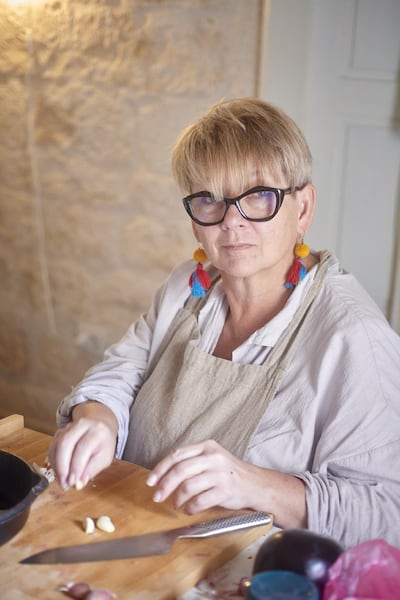After an absence of nearly 40 years, I arrived back in Puglia on May 10th, 2019, me and my purple aubergine of a car, rammed full with pretty much everything I owned. We entered by a back route, unpropitious with its potholes and twists and turns, squiggling along the northern perimeter of the Gargano Peninsula to Vieste at its tip. Here at last.
About a year earlier I'd had one of those light-bulb moments. I would move lock, stock and barrel to the south of Italy. I'd just interviewed the author and restaurateur Russell Norman about his book Venice, an account of a year lived in the backstreets of Venice learning to cook like the locals. There was an audience, so I was trying to appear professional and thoughtful, but was horribly distracted by two thoughts: 1. This man is so bloody gorgeous and charming, and 2. I am so jealous – why haven't I ever done something like this?

Two days later, I was procrastinating my way down an internet path to nowhere when I came across a story about a little town called Candela in the north of Puglia that was paying people to move there. And right then and there it struck me. I could and I would. I was going to move to the south of Italy.
*******
Though Puglian cooking is obviously Italian, it has a beating heart that is all its own. It takes, ooh, about all of 24 hours to begin to spot the differences. Keep looking and they merge into a unique cuisine carved out of the land, poverty, cavalcades of invaders and a joyful greed for good food. You soon learn here that food is highly localised, and universally treasured. In my new home town, I asked for a pasticciotto (a divinely crumbly pastry filled with crème patissière). Oh, mad Englishwoman! "They're a speciality of Lecce [all of 40 miles away]. We don't make them here." Actually you can get them all over the place (including the deep-freeze section of a local supermarket), but her point was clear.
Ten miles in the other direction is the town of Cisternino, where so many of the town’s restaurants aren’t restaurants, at least not in the daytime. They’re butchers shops, selling impeccably displayed raw meat to whoever wants it. The display is still there in the evening, but the back rooms have opened and the butchery is transformed into a braceria or rosticceria. Hell for vegans, paradise for carnivores. Charcoal-grilled steaks, sausages and chops, but best of all, to my mind, are the bombette, little rolls of meat and cheese and herbs, oozing and tender.
In Oria, I am introduced to the pignata, a clay pot for cooking stews, buried overnight in the embers of a wood-fired oven. Here they stew beef, pork, horse or donkey in a lake of rich tomato sauce. Some of that sauce is siphoned off to dress pasta, the rest eaten with the now phenomenally tender meat. Over on the coastal instep, in pre-season Porto Cesareo, I order a pignata di polpo. Octopus cooked so slowly in its earthenware that it is as soft as butter, richly seasoned, but with barely a trace of sauce.
One of Candela's home products is grano arso, literally burnt grain, not the mistranslated 'big bottom" that makes me giggle childishly'
When I first looked out from the heights of Candela’s main street, the early June landscape was a patchwork of golden wheat stubble, olive groves, vines jacketed in plastic sheeting to protect against storms, and wind turbines. Hundreds of wind turbines, harvesting the gusts of air. There it was, spread out below me – wheat, wine and olive oil. The foundation stones of every meal in this blessed, endlessly fought-over (Ostrogoths, Greeks, Normans, Arabs, Austrians, Turks, French, Spaniards and Romans have all claimed it at one time or another), now often-overlooked patch of land.

Add to that the sweet, sweet tomatoes, the bitter lampascioni (muscari bulbs), garlic, rich cheeses (especially burrata, created here in Puglia a century ago), cured capocollo and chilli-seared soppressata salami. Only an hour’s drive away, east and west, the long coastline delivers fish, octopus, crabs and mussels to strings of small ports with their bobbing fishing boats and early-morning harbour markets.
One of Candela's home products is grano arso, literally burnt grain, not the mistranslated "big bottom" that makes me giggle childishly. Whole grains of wheat are roasted to within a millimetre of their lives, then ground to a fine flour and used for pasta (particularly orecchiette) and bread. Negroamaro and Primitivo grapes put flasks of wine on tables and in the increasing warmth of the June sun, the inhabitants of Turi turn out to celebrate the Sagra della Ciliegia Ferrovia, the Festival of the Railway Cherry, a plump, juicy variety named for the train tracks that ran alongside the original grand-daddy of a tree.
I knew when I arrived that Puglia was a region I want to get to know intimately, to understand culture, life, history and geography, reflecting through the prism of the food that’s put on the tables of locals and of tourists, too. I’m reminded of my 20-year-old self, scribbling in notebooks as I first travelled through Italy’s south, only this time I’m back to stay.
A Curious Absence of Chickens: A journal of life, food and recipes from Puglia, by Sophie Grigson, is published by Headline Home, €23










